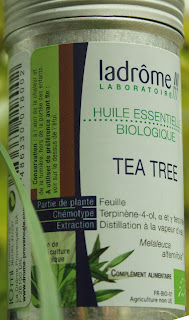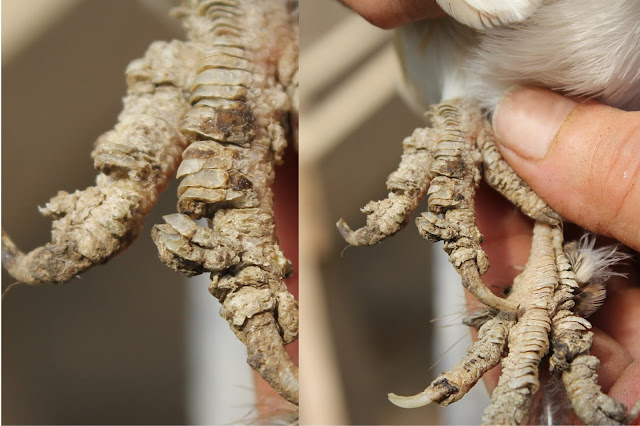Below you can see the difference after over a week of dust-bathing and my quail working on her feet. There is still more to do but I have given her legs another bath in the mixture and will monitor to see what happens. Remember these minute spiders have burrowed into the scales, so they need to be worked on gently preferably by the quail herself. She will remove dead mites and debris at her own pace and so as not to give herself pain or injury to the skin. At the same time as I retreated her I also did the same to all the other quail too. The film for the whole chronological process can be found at the end of this article.
In the above image you can see in detail the problems that scaly mite can cause to the nails, as they become crooked and thickened with the addition of mite activity. If left unchecked this can lead to the loss of the claw. What is also clear in this photograph is the progression of the damage to the scales as the colony grows. On parts of the foot we can observe the scales are barely lifted where the activity is lesser. Where there are larger numbers of mites, the scales have been lifted at a 90° angle to its normal position. It is also in these latter cases that the mites will be more difficult to remove, as they are embedded deeper into the skin and each layer of mite is protected beneath a further layer of mites and debris. As an extra happy indication we can also deduce, from the grimy claws, that my quail has been digging again now her feet and legs feel better and her nails have been trimmed!
 |
| Polly teaches one of her quail chicks about dust-bathing |
Again this is the reason why I like my birds to do their own removal and at their own pace. As you can see from the images (above top) the quail has already removed some of the larger excrescences leaving the skin undamaged beneath, as these mites have already been killed where the oil and essential oil have soaked through the layers and done their job.
Another five days later and you can see that further progress has been made. With none but the most stubborn of the mite colonies still remaining. I'm now rubbing pure coconut oil into these areas to help in the repair of the skin and the regrowth of the scales.
Calendula Infused Oil
With my scaly face patient, I am now using organic calendula oil to aid in skin regeneration and repair to the base of the feathers and also to soothe and stop any irritation of the skin.
Calendula infused oil is simple to make even from scratch, as pot or common marigolds are very easy to grow and produce a prolific number of blooms over a long flowering period. In a future article I will be showing how to make this incredibly useful and ancient medicinal.
 Named ringelblummen or ringlet flower by the mystic, scholar, writer and holistic health practitioner Hildegard von Bingen
because of the curly nature of the seeds. One of the perceived
Mediaeval virtues of this flower was in the treatment of poisonous bites.
Named ringelblummen or ringlet flower by the mystic, scholar, writer and holistic health practitioner Hildegard von Bingen
because of the curly nature of the seeds. One of the perceived
Mediaeval virtues of this flower was in the treatment of poisonous bites.Scaly leg and face mites exude a caustic liquid that enables them to burrow into the scales and skin, which links us neatly back to this ancient medicinal.
 One of the most versatile flowers for use in a whole raft of medical conditions from sore gums to bunions, marigolds are perhaps most famously known in modern times through the foundation of the Marigold Clinic in the Royal London Homeopathic Hospital.
One of the most versatile flowers for use in a whole raft of medical conditions from sore gums to bunions, marigolds are perhaps most famously known in modern times through the foundation of the Marigold Clinic in the Royal London Homeopathic Hospital.
The common marigold calendula officinalis was so called because of its ability to bloom at all times of year, .i.e. throughout the calendar. It's common name 'marigold' comes, it is said, from its use as an offering to the Virgin Mary as an alternative to coin.
Another 'marigold' tagetes patula also makes a very useful, anti-inflammatory infused oil and is a flower associated with offerings in many religions including Hindu, Buddhist and Ancient Aztec. it's an oil I have also made and used on my chickens for scaly leg. Tagetes and calendula infused oils are regularly used in humans for athlete's foot as they are both powerful anti-fungals.
In gardening tagetes of the Dwarf African Marigold species are planted between tomato plants to ward off and kill nematodes or round worms which attack tomato roots. The active compound is the phototoxin, α-therthienyl.
- Plant sterols - calendulin
- Calendic acid
- Polysaccharides
- Linoleic acid
- Carotenoids
- Flavonoids
- Triterpenes saponins, such as triterpenoid
- Tocopherols
- Oleanolic acid glycosides
The virtues of Calendula infused oil we are interested in here are:
- the treatment of inflammatory skin disorders
- wound healing
- treatment of skin irritations
- the strong smell - which has an effect on invertebrates (the flowers can be companion planted in gardening as an insect repellent).
As with the coconut and tea tree mixture you can put the oil in place using a cotton bud or with your finger.
I can attest that for days now I have not seen my quail scratching her neck and the feathers are growing back and the skin looks pink and healthy.
Here's the film:
Here's the film:
Thanks
for dropping by and do feel free to share experiences or ask for
further information in the comment section. If you have enjoyed this
piece and found it
useful think about sharing it with your family and friends, on social
media and also maybe about joining this blog
and/or subscribing to my Youtube channel or even supporting us on
Patreon or
It all helps to keep me going!
Until next time, all the very best from sunny Normandie! Sue
RELATED ARTICLES
Scaly Leg/Tassel Foot & Scaly Face in Quail
Knemidocoptes mutans a very
successful, microscopic burrowing mite, is one I have dealt with before
within these pages in its relationship to my hens and cockerels. I also
mentioned that it could....read more
Treating an injured quail Nutritional support for sprains, strains and nerve damage
Here's Drusilla she is one of my coturnix quail and over the past few
days she has started to limp, holding up her foot and hopping...read more
Treating inflammation and infection with cabbage poultices
Recently
I had occasion to use this poultice on two cases simultaneously, my quail and
my neighbour's hen's suspected bumblefoot.. ...read more
Treating a nasty head wound and shock
Our poor quail, Nuggets with a horrible injury to her head and eyes (Happy ending!) ...read more
Image of Hildegard von Bingen thanks to the Pinterest Board of Heilpraktiker Berufs-Bund
© 2020 Sue Cross










































